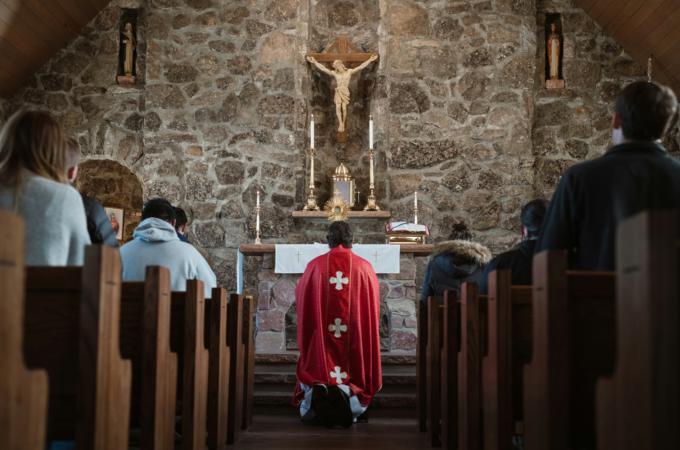Made for worship
I don't remember what it was like to attend Mass before Vatican II, but I've heard plenty of stories. There were no Saturday vigil Masses, so everyone worshipped together on Sundays. Everybody came to Mass in their "Sunday best": men wore jackets and ties, and women and girls donned hats or veils; priests dressed in cassocks and birettas. Organs blared and choirs sang from the loft, but there was also plenty of silence. Latin was beautiful, but also incomprehensible. It wasn't easy to know what exactly was going on. Those who wanted to follow along brought a missal to Mass, but many just prayed the rosary. Except for the psalms, readings were from the New Testament only. Priests led their congregations in prayer, turning toward the altar of sacrifice. The incense was smoky and thick. The people knelt at a Communion rail to receive the sacred Host. Priests usually returned to the sacristy right after the final blessing. They were among the most respected members of the community; most parishioners never knew their first names. For some, the Tridentine Mass was mystical and glorious; for others, it was enigmatic and staid.
Last Sunday was the 50th anniversary of the Novus Ordo, but it's hard to say whether this milestone is "golden." When the "new Mass" was rolled out in 1969, it was not greeted with universal enthusiasm. (Of course, neither was the Council of Trent or the Nicene Creed.) It did, however, inspire a whole lot of confusion and controversy.
It's easy to imagine why the Church decided to suppress the Traditional Latin Mass at the time. The cries for unity are still echoing from both sides of the divide, and not always in charitable ways. But in retrospect, it probably would have been better to allow for more diversity of rites. The Western Church, however, has always been uncomfortable with that approach; I'm not sure anyone really knows why. When Pope Benedict XVI published "Summorum Pontificum" in 2007, he restored that possibility moving forward. Because of it, we now see people drawn back to the mystical beauty of the Traditional Latin Mass. But we also see the discussion that never had a chance to occur among lay people in 1969 taking place. And it isn't always pretty.
Catholics who love Latin and chant and "ad orientem" are often viewed with suspicion by those who don't. Just ask any female Catholic who chooses to veil. On the other hand, Catholics who prefer the Novus Ordo are sometimes treated as if they are insufficiently reverent, uncultured, and less spiritual than the more traditional set.
I think everyone should take liturgical field trips. It's good to get out of your own zone of comfort and complacency and experience how other people encounter God differently from the way you do. Every Catholic should make the effort to attend a Traditional Latin Mass. But I also think every Catholic should experience the Divine Liturgy of the Eastern Churches, and Mass as it is celebrated in African American, Spanish-speaking, and Asian communities. While we will be drawn to some styles of worship more than others, we should learn to love the liturgy God has given us in all its forms.
Love for the Mass is, I think, the core of the liturgical tensions we are seeing now in the Church. Extraordinary Form Catholics -- both clergy and lay -- are committed to celebrating the Mass in all its richness and beauty. They say all the black and do all the red. The result is that people leave church feeling like they've worshipped God. I suspect it has far more to do with attentiveness than it does with Latin. It also has something to do with the fact that these congregations are usually small enough to become authentic Christian communities.
In contrast, it can be hard to find a Novus Ordo parish that loves the Mass enough to do it well. That's a tragedy, because when it is celebrated in fullness, the Novus Ordo is beautiful! The fact is that too many parish leaders don't just simplify our liturgies; we minimize them. We omit the propers (most Catholics don't even know what they are!); we sing a limited repertoire of secular-styled music from the 1980s and 1990s (much of which is not suitably composed for congregational singing!); we use the same Mystery of Faith all year long (there are three), and fail to chant (or even recite) the Gospel Sequences on our holiest Solemnities. It's a challenge to find a Christmas Eve midnight Mass that is actually held at midnight. All in the name of pastoral sensitivity.
And yes, I know that priests, deacons, and parish staffs are overworked. But 50 years have passed, and not very many of us ever quite got around to restoring all the things our predecessors set aside to make the transition to the Novus Ordo easier. Now is the time to reclaim the rich inheritance we've lost. Our hearts were made for worship.
- Jaymie Stuart Wolfe is a Catholic convert, wife, and mother of eight. Inspired by the spirituality of St. Francis de Sales, she is an author, speaker, and musician, and serves as a senior editor at Ave Maria Press. Find Jaymie on Facebook or follow her on Twitter @YouFeedThem.



















